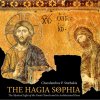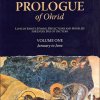The Mystical Light of the Great Church and its Architectural Dress
by Charalambos P. Stathakis
Dear reader, as you run like the rest of us along the dizzy main road, stop, stay aside for a while. Let the others be dizzy, and take the secret underground trail, which will lead you through the dewdrops of the leaves, the crystal smile of the sun, the city’s underground galler- ies, your knowledge, and your feelings, to the doorstep of the Hagia Sophia. Because all dew- drops, all sunrays, and all beauty lead there. That is what you will be told by my friend, the author, whom I am fond of and whom I send you to, Charalambos Stathakis: the doctor, the warm and humane researcher, the scientist devoted to his work and his patients, who has given a series of scientific papers, who, nevertheless, retains a nest of beauty untouched in his heart, which makes him outstanding—even though he is not a specialist in architecture, nor a historian, nor a theologian, nor a Byzantinist—it makes him stand out in all these together and in entirety.
If you let yourself into his relentlessly personal approach to the Hagia Sophia with humble obedience, the light that transforms the building and is transformed in the building will be revealed to you.
Watch how he stands in front of Hagia Sophia, how he walks among her gold-lit corners, how he touches her heaven-dropped structures, and how he converses with her history, her legends, the interpretations of architects and theologians—he who is the least of all, but because of this also the first. Follow him with discipline on this trail. Work hard to comprehend him. Then return to the beginning to experience it again written in full and in one piece. Study his illustrations with patience. Do not halt on some technical imperfections. Receive what you are given. It comes from a non-specialist and this is why it helps us non-specialists to comprehend the Church, which may be simple in the experience it conveys, but not in its structure and its structural solutions. This is why it is revealed to us gradually by the mystagogical text and the accompanying illustrations. In this way, reader, you will experience the blessed originality of the author in interpreting architecture and space through light.
You will then see how the light helps him in a pioneering comprehension of this mystery: a) in the answer he gives to the question of whether the two external buttresses were con- ceived by Anthemios and Isidore from the start, b) in the explanation of the enormous exte- rior arches based on light, c) in the explanation of the contrast between the exterior and interior thickness of the arch (which, in our view, constitutes the correct understanding of Agathias’ text), d) in the understanding of the ellipticity of the dome, e) in the analysis, for the first time, of the significance of the plaque with the representation of the Church, above the central door in the interior of the Church, f ) in perceiving the lack of harmony in the relationships between the parts of the Church as a transcendence of the “perfection of measurement” for the sake of “spiritual perfection,” and g) in his original point of view about the interior decoration, that is, whether or not there was iconography in the Hagia Sophia from the beginning. Stride the bridge which breaks through the light, dear reader. Follow humbly, with asceticism and obedience, the revelation granted to you by Charalambos Stathakis, a personal interpreter, a relentlessly personal seer, who has a vision of the Great Church, not simply as a resplendent building, but as a living Entity with characters of a Person.
Fr. Stamatis Skliris





